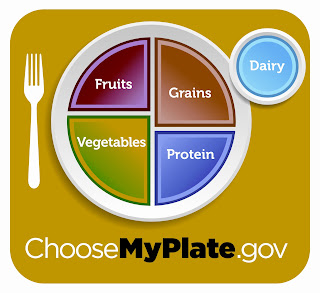
Last week the United States Department of Agriculture unveiled the new icon for following a healthy diet, Choose MyPlate.gov http://www.choosemyplate.gov/ This is intended to replace the last icon, MyPyramid, introduced in 2005. I am an instant fan of MyPlate. It is immediately understandable, even to elementary children. It contains proportionality, so we know to eat half our plate vegetables and fruits, and keep the other half grains and protein. What does need a little more explanation is that we want to teach eating more whole grains, or at least half our daily servings of grains. So, I think they could have labeled it whole grains instead. The other tricky part is: what is protein? Since it includes meats, poultry, fish, nuts, seeds, beans and legumes, I guess that is too much to fit in that small wedge.
Then there is the dairy circle. I am glad it is there, but it also now includes non-dairy soy products fortified with calcium and Vitamin D for our vegan dieters. Cheese, yogurt, and milk of course are included, even though it is not immediately discernable from the circle off the plate.
It is a great teaching tool nonetheless, and a great conversation starter. To further the discussion, USDA includes the following teaching points to get you on the road to a better diet:
Balancing Calories
Enjoy your food, but eat less.
Avoid oversized portions.
Foods to Increase
Make half your plate fruits and vegetables.
Make at least half your grains whole grains.
Switch to fat-free or low-fat (1%) milk.
Foods to Reduce
Compare sodium in foods like soup, bread, and frozen meals ― and choose the foods with lower numbers.
Drink water instead of sugary drinks.